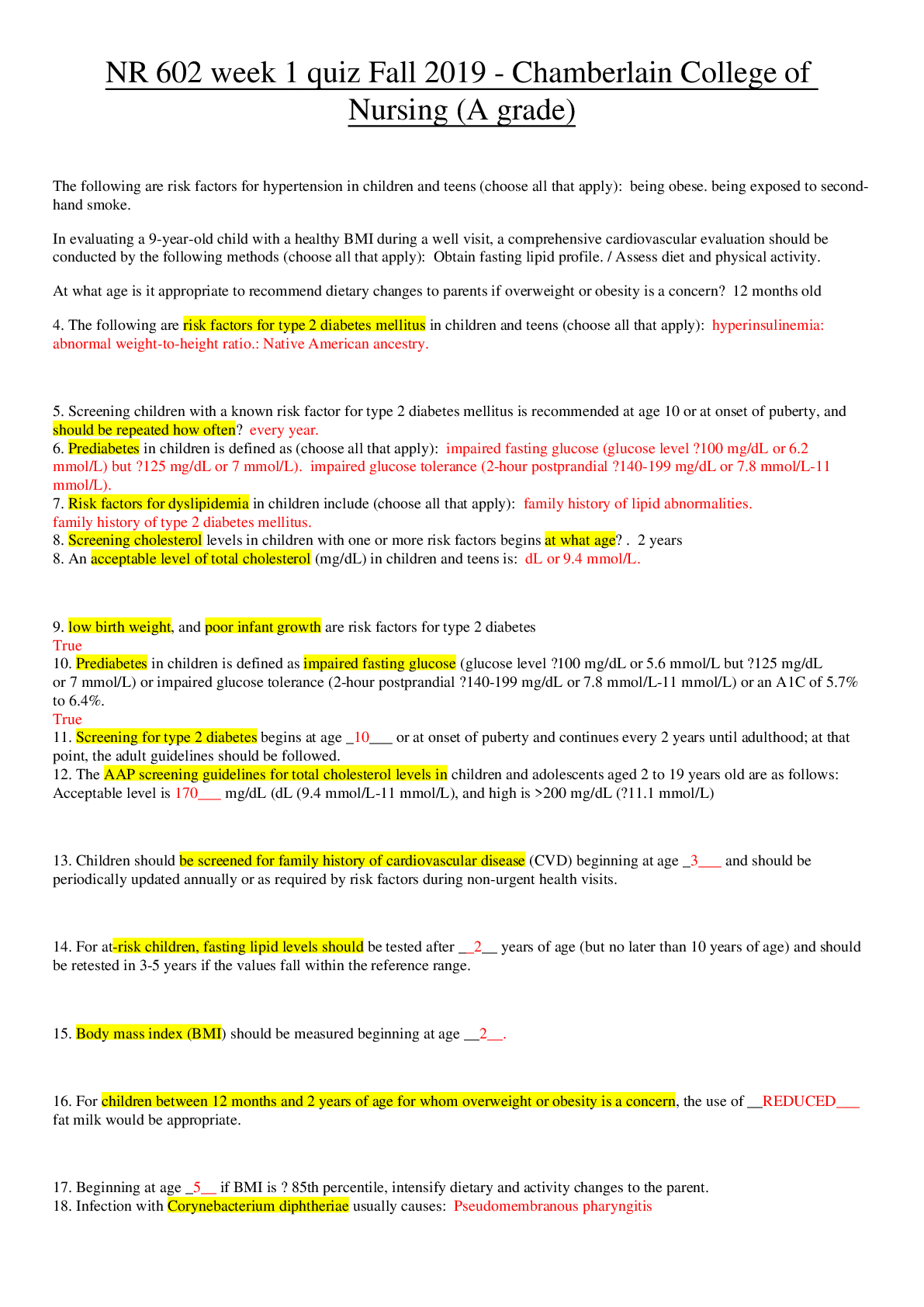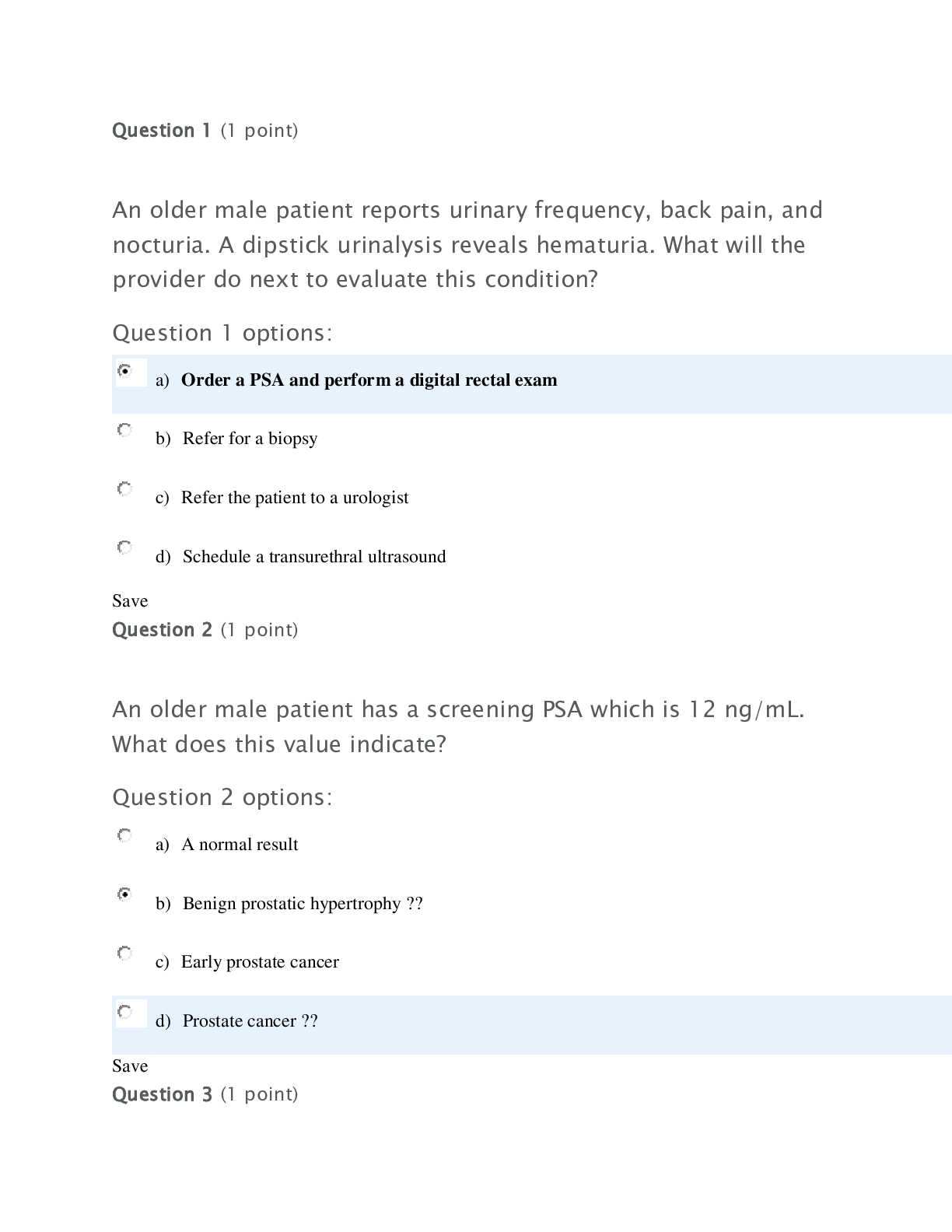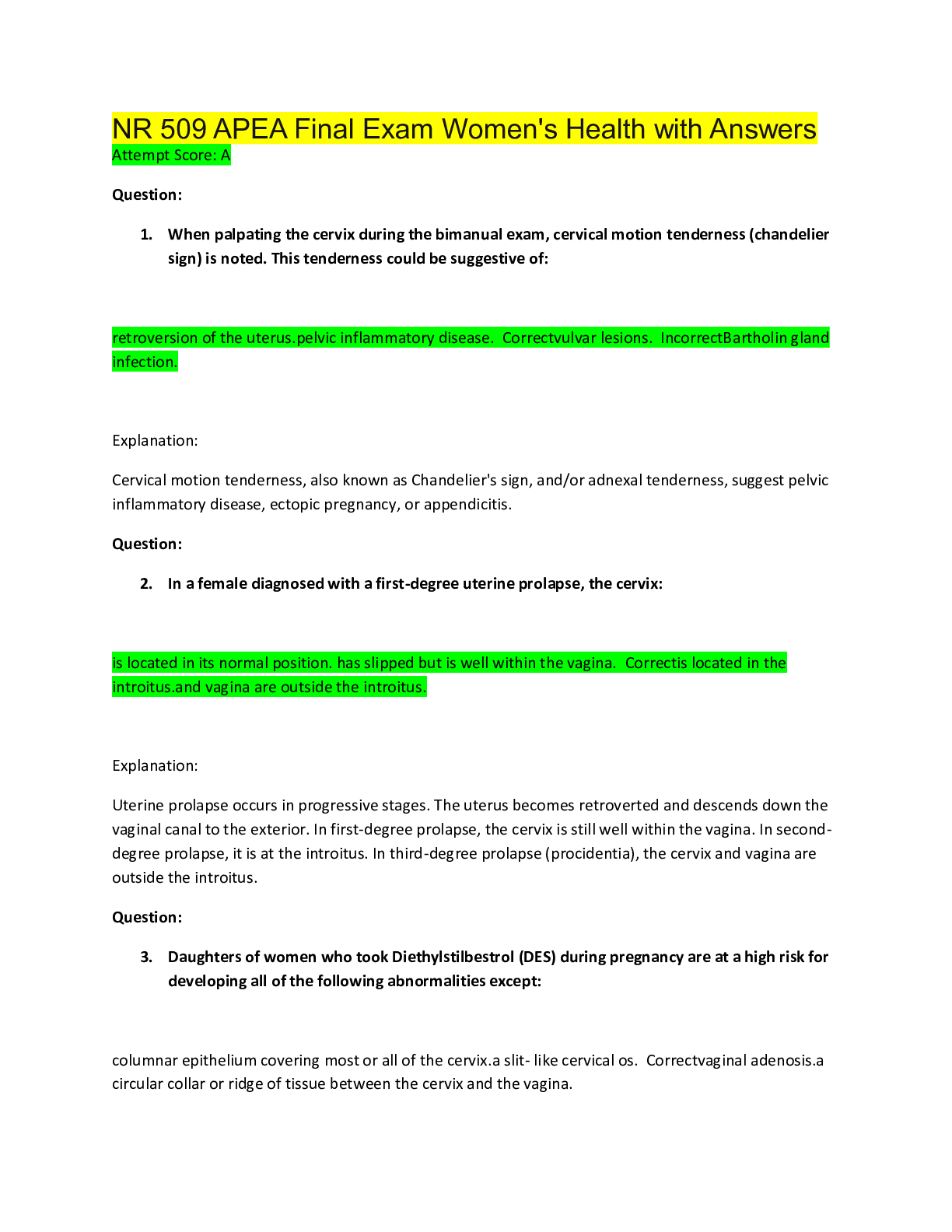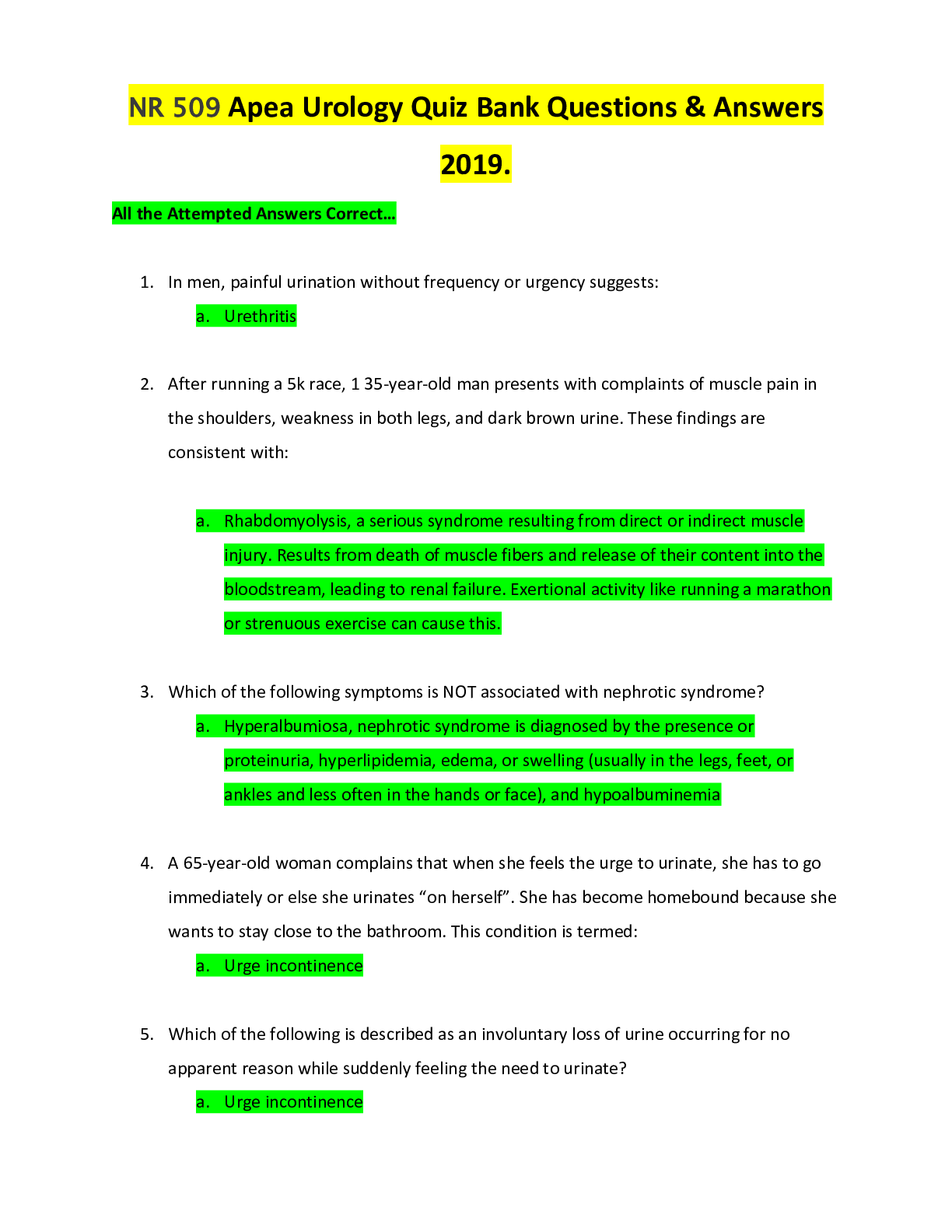NR 602 week 1 quiz Fall 2019 - Chamberlain College of Nursing (A grade)
Document Content and Description Below
NR 602 week 1 quiz Fall 2019 - Chamberlain College of Nursing (A grade) 1. The following are risk factors for hypertension in children and teens (choose all that apply): �... �� 2. In evaluating a 9-year-old child with a healthy BMI during a well visit, a comprehensive cardiovascular evaluation should be conducted by the following methods (choose all that apply): 3. At what age is it appropriate to recommend dietary changes to parents if overweight or obesity is a concern? 4. The following are risk factors for type 2 diabetes mellitus in children and teens (choose all that apply): 5. Screening children with a known risk factor for type 2 diabetes mellitus is recommended at age 10 or at onset of puberty, and should be repeated how often? 6. Prediabetes in children is defined as (choose all that apply): 7. Risk factors for dyslipidemia in children include (choose all that apply): 8. Screening cholesterol levels in children with one or more risk factors begins at what age? . 2 years 8. An acceptable level of total cholesterol (mg/dL) in children and teens is: 9. low birth weight, and poor infant growth are risk factors for type 2 diabetes 10. Prediabetes in children is defined as impaired fasting glucose (glucose level ≥100 mg/dL or 5.6 mmol/L but ≤125 mg/dL or 7 mmol/L) or impaired glucose tolerance (2-hour postprandial ≥140-199 mg/dL or 7.8 mmol/L-11 mmol/L) or an A1C of 5.7% to 6.4%. 11. Screening for type 2 diabetes begins at age ____ or at onset of puberty and continues every 2 years until adulthood; at that point, the adult guidelines should be followed. 12. The AAP screening guidelines for total cholesterol levels in children and adolescents aged 2 to 19 years old are as follows: Acceptable level is < _____ mg/dL (<9.4 mmol/L), borderline is 170-199 mg/dL (9.4 mmol/L-11 mmol/L), and high is >200 mg/dL (≥11.1 mmol/L) 13. Children should be screened for family history of cardiovascular disease (CVD) beginning at age and should be periodically updated annually or as required by risk factors during non-urgent health visits. 14. For at-risk children, fasting lipid levels should be tested after ____ years of age (but no later than 10 years of age) and should be retested in 3-5 years if the values fall within the reference range. 15. Body mass index (BMI) should be measured beginning at age ____. 16. For children between 12 months and 2 years of age for whom overweight or obesity is a concern, the use of __ ___ fat milk would be appropriate. 17. Beginning at age ___ if BMI is ≥ 85th percentile, intensify dietary and activity changes to the parent. 18. Infection with Corynebacterium diphtheriae usually causes: 19. The tetanus infection is caused by ___ _____, an anaerobic, gram-positive, spore-forming rod. This organism is found in soil and is particularly potent in manure. 20. Sources of lead that can contribute to plumbism include select traditional remedies such as azarcon and greta. 21. Patients with plumbism present with which kind of anemia? 22. Intervention for a child with a lead level of 5 to 44 mcg/dL usually includes all of the following except: 23. Ingested lead inactivates heme synthesis by inhibiting the insertion of iron into the protoporphyrin ring. This leads to the development of what kind of anemia? microcytic, hypochromic 24. __ ________ stippling is often noted on red blood cell morphology in lead poisoning. 25. Lead is significantly toxic to the, 26. Long-term complications of __ ______ poisoning include behavior or attention problems, poor academic performance, hearing problems, kidney damage, reduced IQ, and slowed body growth. 27. Unless deleading procedures have been performed, however, most homes built before __contain lead-based paint. 28. A diet low in calcium, iron, zinc, magnesium, and copper and high in fat, which is a typical diet for children living in _____ _____, enhances oral lead absorption 29. In older homes, the point of greatest risk is the __ ___ because their sills and the putty have high lead concentration. Because toddlers (age 2 to 3) are the ideal height to reach them and are often drawn to open ones, they are at greatest risk and summer is the riskiest season. 30. Symptoms of elevated __ ____ levels include abdominal pain and cramping, aggressive behavior, anemia, constipation, difficulty sleeping, headaches, irritability, loss of previous developmental skills in young children, low appetite and energy, and reduced sensations. Very high levels can result in vomiting, staggering walk, muscle weakness, seizures, or coma. 31. A measure of __mcg/dL is now used to identify children with elevated blood lead levels. 32. Most children with lead levels of 5-44 mcg/dL are treated with removal from the source, improved nutrition, and ___ ___ therapy. 33. Those with lead levels of 45-50 mcg/dL are treated with a ___ __agent such as succimer, in addition to the previously listed interventions. 34. For children with lead levels of greater than 51 mcg/dL, hospital admission with expert evaluation is likely the most prudent course to avoid serious problems (including ___ __) associated with markedly elevated lead levels 35. Which of the following represents the best choice of clinical agents for a child who has had a history of penicillin allergy who requires antimicrobial therapy? 36. The clinical presentation of UTI in children can be without the classic symptoms such as frequency, dysuria, or flank pain. 37. In younger children, UTI often manifests as ___ _, ___ __, and __ ___ with no obvious focal infectious source. 38. Older children with UTI often present with __ ___ pain, unexplained fever, or both; as children approach puberty, flank pain becomes more common 40. ______ should be considered in infants and young children 2 months to 2 years old with unexplained fever, particularly in boys younger than 6 months and girls younger than 2 years who have a temperature greater than or equal to 39°C (≥102.2°F). 41. A _____ ____ should be obtained in a child with unexplained fever or symptoms that suggest a UTI; however, 20% from UTI cases return a false-negative result. 42. Any of the following findings are suggestive, although not diagnostic, of UTI: positive leukocyte esterase, positive nitrite, more than _white blood cells (WBCs) per high-power field in spun specimen, and bacteria present in unspun Gramstained specimen. 43. An acceptable method because of the low rate of skin and fecal contamination is a urine specimen collection via bag or from the diaper. 44. a single documented UTI in a child must be taken seriously. If an infant or young child 2 months to 2 years old with suspected UTI is assessed as toxic, dehydrated, or unable to retain oral intake, ___ ___is advised. 45. Oral amoxicillin, TMP-SMX, or a second-or third-generation __ ________ is recommended as options for initial therapy for UTI in children 46. The use of _ - ______ has a small risk of treatment failure. 47. Current evidence-based practice recommendations for UTI in Children indicate a _____ to ______ day course of antibiotics because the outcomes are superior to a 1-to 3-day course in preventing spread of infection and subsequent renal scarring. 48. Although fluoroquinolone antibiotics have not been widely used in children, ciprofloxacin is approved by the U.S. Food and Drug Administration (FDA) for use in pediatric patients for the treatment of UTI; this use is approved starting at age ____ years old. 49. Urinary tract imaging should be considered for all children with UTI, particularly if this occurs before toilet training. 50. The two mainstays for imaging for UTI in young children are _ _____(RBUS) and voiding cystourethrography (VCUG) 51. RBUS is an easily obtained, noninvasive test but can miss a small number of high-grade ___ _____ cases 52. The benefits of ___ _______ (no radiation exposure, non-invasive, minimal discomfort for child and parents), however, outweigh the slight increase in specificity of VCUG 53. A __ ______ scan is useful for detecting renal scarring, a finding present after infection, but is not recommended for routine, initial evaluation of young child with their first febrile UTI. 54. ___ _____ only is indicated if RBUS reveals hydronephrosis, scarring, or other findings that would suggest either high-grade vesicoureteral reflux (VUR) or obstructive uropathy, as well as other atypical or complex clinical circumstances. 55. A 4-year-old child presents with fever; exudative pharyngitis; anterior cervical lymphadenopathy; and a fine, raised, pink rash. The most likely diagnosis : 56. An 18-year-old woman has a chief complaint of "a sore throat and swollen glands" for the past 3 days. Her physical examination reveals exudative pharyngitis, minimally tender anterior and posterior cervical lymphadenopathy, and maculopapular rash. Abdominal examination reveals right and left upper quadrant abdominal tenderness. The most likely diagnosis is: . 57. Kawasaki disease most commonly occurs in what age group? 58. For acute phase illness (usually lasts about 11 days), fever with T104ºF (40ºC) lasting5 days, polymorphous exanthem on trunk, flexor regions, and perineum, erythema of the oral cavity ("strawberry tongue") with extensively chapped lips, bilateral conjunctivitis usually without eye discharge, cervical lymphadenopathy, edema and erythema of the hands and feet with peeling skin (late finding, usually 1-2 weeks after onset of fever), no other illness accountable for the findings. Usually in children age 1-8 years Treatment with IV immunoglobulin and PO aspirin during the acute phase is associated with a reduction in rate of coronary abnormalities such as coronary artery dilatation and coronary aneurysm. Expert consultation and treatment advice about aspirin use and ongoing monitoring warranted. 60. Rates of urinary tract infection (UTI) among uncircumcised infant boys are how much higher than those in circumcised boys? as much as 20% 61. Which of the following is most likely to be part of the clinical presentation of UTI in a 20-month-old child? 62. Which of the following is considered the ideal method for obtaining a urine sample for culture and sensitivity in an 18-month-old-old girl with suspected UTI? 63. When choosing an antimicrobial agent for the treatment of UTI in a febrile female child who is 16 months old, the NP considers that: 64. When evaluating the urinalysis of a 10-month-old infant with UTI, the NP considers that: 65. In children 2 months to 2 years old with UTI, antimicrobial therapy should be prescribed for: 66. The preferred urinary tract imaging study for a 22-month-old girl with first-time febrile UTI is: 67. VCUG is indicated: 68. The urinary tract abnormality most often associated with UTI in younger children is: . 69. Signs of severe dehydration include (choose all that apply): 70. The onset of symptoms of food poisoning caused by Staphylococcus species is typically how many hours after the ingestion of the offending substance? 71. The onset of symptoms in food poisoning caused by Salmonella species is typically how many hours after the ingestion of the offending substance? 72. What percentage of body weight is typically lost in a child with moderate dehydration? 6-10% 73.Clinical features of shigellosis include all of the following except: 74. acute gastritis usually does not have a fever 75. Asking about the last urination is a helpful way of evaluating dehydration. If the child has voided within the previous few hours, the degree of dehydration is minimal. 76. Because they contain inappropriate glucose and electrolyte composition, sports drinks such as Gatorade (tm), soda, and most fruit juices are _______ ___for rehydration. inappropriate 77. The use of antidiarrheal agents is usually discouraged because of the risk of increasing the severity of illness if toxinproducing bacteria are the causative agent. 78. Warning signs during acute gastroenteritis include ____ ___ coupled with _ __or __ __-filled stools. If these are present, a bacterial source of infection such as shigellosis should be considered. Stool culture should be obtained, and appropriate antimicrobial therapy should be initiated. 79. Precocious puberty in girls has long been defined as the onset of secondary sexual characteristics before the child's _______ birthday. 80. In boys, precocious puberty is defined as the onset of secondary sexual characteristics before his ______ birthday. 81. Thelarche (the isolated appearance of breast development) is common as early as age __. 82. . Pubarche (the appearance of pubic hair without other signs of puberty) as early as age ___ in otherwise healthy girls. 83. A subset of girls, particularly girls with pubertal changes noted before their ______ birthday, often has significant health problems, however, such as ovarian or adrenal tumors. Expert evaluation and referral is indicated in these children. 84. Delayed puberty is defined as no evidence of sexual maturation (Tanner stage 1) in girls older than age ____and in boys older than age _____. 85. The most common reason for precocious puberty in girls is: estrogen... 86. The most common reason for precocious puberty in boys is: . 87. Which of the following is noted in a child with premature adrenarche? 88. Girls typically grow to their adult height by 89. A 15-year-old male is found to be at Tanner stage 1 on exam. The least likely cause of this finding is: 90. An innocent heart murmur has which of the following characteristics? 91. The murmur of atrial septal defect is usually: 92. A Still murmur: 93. Grade 1-3/6 early systolic ejection, musical or vibratory, short, often buzzing, heard best midway between apex and LLSB. Softens or disappears when sitting, when standing, or with Valsalva maneuver Louder when supine or with fever or tachycardia Usual onset age 2-6 years; may persist through adolescence Benign condition 94. Grade 1-2/6 systolic ejection, high-pitched, heard best in pulmonic and aortic areas. Heard only in presence of increased cardiac output, such as fever, anemia, stress. Disappears when underlying condition resolves Usually seen without cardiac disease Most often heard in children and younger adults with thin chest walls 95. Grade 1-2/6 continuous musical hum heard best at upper right sternal border (URSB) and upper left sternal border (ULS) and the lower neck. Disappears in supine position, when jugular vein is compressed Common after age 3 years. Believed to be produced by turbulence in subclavian and jugular veins Benign condition 96. Grade 1-3/6 systolic ejection murmur, heard best at ULSB with widely split fixed S 2. Accompanying mid-diastolic murmur heard at fourth intercostal space (ICS) left sternal border (LSB); commonly caused by increased flow across tricuspid valve. Two times as common in girls Child is often entirely well or present with heart failure Often missed in the first few months of life or even entire childhood Watch for children with easy fatigability Cyanosis rare 97. Grade 2-5/6 regurgitant systolic murmur heard best at LLSB Occasionally holosystolic, usually localized. Thrill may be present and a loud P 2 with large left-to-right shunt. Usually without cyanosis Children with small-to moderate-sized left-toright shunt without pulmonary hypertension likely to have minimal symptoms Larger shunts may result in CHF with onset in infancy 98. When counseling the family of an otherwise healthy 2-year-old child who just had a febrile seizure, you consider the following regarding whether the child is at risk for future febrile seizures (choose all that apply): 99. A simple febrile seizure actually is most likely to occur as fever is ___ _(increasing or decreasing) rather than at its peak; however, there is no evidence that the rapidity of the rate of increase is associated with febrile seizures. 100. A familial tendency has been noted with febrile seizure, but is the condition predictive of the development of epilepsy? 101. A simple febrile seizure is a benign, although frightening, common event in children _months to ____years old; a child who has had one seizure is at increased risk for a recurrence. 102.Most children with febrile seizures do not need to be treated with medication. Daily phenobarbital and valproate, reduce risk and could prevent occurrence but risks outweigh the benefits …. 103.In situations in which parental anxiety about febrile seizures is severe, intermittent oral diazepam (Valium) at the onset of febrile illness. 104. Do antipyretics prevent febrile seizures? 105. You exam a healthy 2 month old boy and note that his foreskin cannot be retracted. You consider that: 106. You examine a thriving 4-week old boy, born at 39 weeks’ gestation, and note a painless, tense, non-reducible, relatively symmetric scrotal enlargement that brightly and evenly trans-illuminates. The parents state the scrotum always looks like this without change in size during the day. Bilateral testes 1 cm in length, are palpable and held within the scrotum. The penis is about 4cm in length. You consider these findings are most consistent with: 107. Most of the time a non-communicating hydroceles will resolve on their own by the time the baby is 1 year old. 108. Communicating or Non-communicating Hydrocele: A Fluid-filled scrotal sac; transilluminates, nontender, testes normal, however amount of fluid in scrotum (scrotal size) varies with position of neonate; larger with dependent upright position (day) and smaller after lying flat (upon awakening) . Due to communication, an infant is at risk for herniation of abdominal contents and should be referred to pediatric urologist or surgeon. 109. A ___ ___hydocele occurs due to sealing of the abdominal cavity during gestation with residual trapped peritoneal fluid in the scrotal sac. 110. What does intussusception result in? 111. What does pyloric stenosis result in? 112. Approximately 4:1 male to female ratio. 113. Sudden onset colicky, severe, an intermittent abdominal pain. 114. Accompanied by loose stools that are often described as currant jelly appearance (Mixture of blood and sloughed mucous). 115. Most common time for symptoms onset = Approximately Age 3 weeks. 116. Post-fed projectile vomiting is present with the baby eager to eat again immediately post emesis 117. Accompanied by a sausage-shaped abdominal mass. 118. Olive Shaped abdominal Mass occasionally noted. 119. Usually occurs in the first year of life 120. Intussusception is caused when a section of intestines invaginates into the adjoining intestinal lumen, causing bowel obstuction, if left untreated is uniformly fatal in __to _____ days. 121. Intussesception symptoms are often preceded by an upper respiratory tract infection. 122. Puberty is the onset of Tanner Stage ___ 123. In a boy Tanner Stage _2 __ consists of testicular enlargement, scrotal skin reddening, sparse growth of long slightly pigmented pubic hair at base of penis. 123. Gynecomastia is usually found in males at which tanner stage/age? 124. You see a 17 year old female, as part of the visit you consider her risk factors for T2 Diabetes would likely include all of the following except: 125. When should you consider doing T2DM screening in Children: 126. If child is overweight or obese initiate testing at age ____ years or at onset of puberty if puberty occurs earlier. Frequency is every ____ years. 127. Microcytic, Hypochromic, Elevated RDW is what kind of anemia? 128. Iron deficiency is most common in children 12-30 months 129. For mild to moderate dehydration oral rehydration therapy with oral rehydration solution is as effective as parenteral therapy, easier to administer and more cost-effective [Show More]
Last updated: 1 year ago
Preview 1 out of 14 pages
Instant download

Buy this document to get the full access instantly
Instant Download Access after purchase
Add to cartInstant download
Reviews( 0 )
Document information
Connected school, study & course
About the document
Uploaded On
May 30, 2020
Number of pages
14
Written in
Additional information
This document has been written for:
Uploaded
May 30, 2020
Downloads
0
Views
160






















